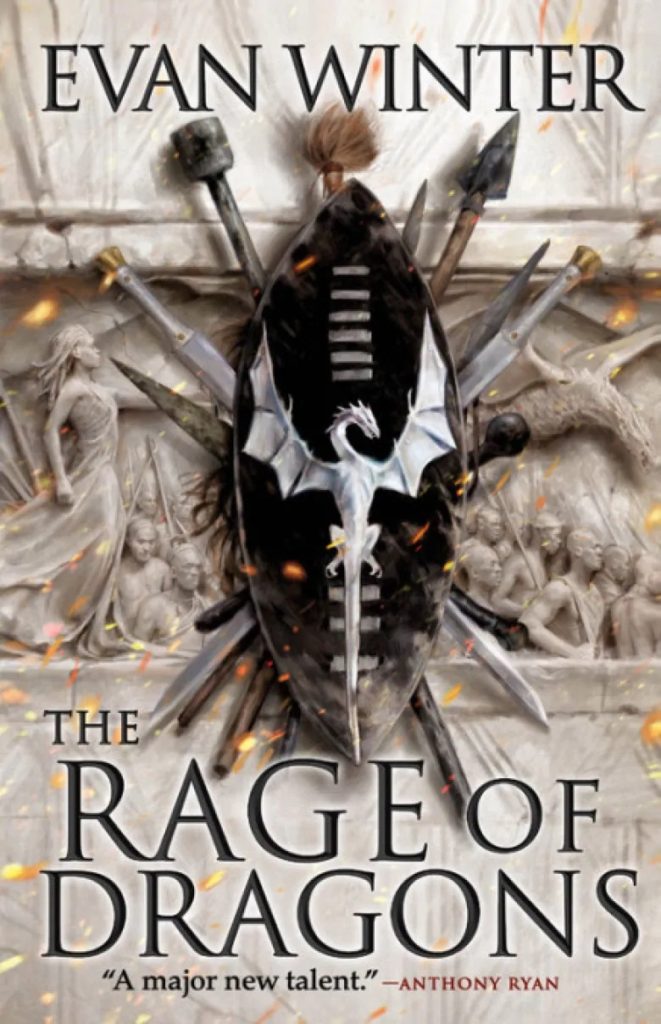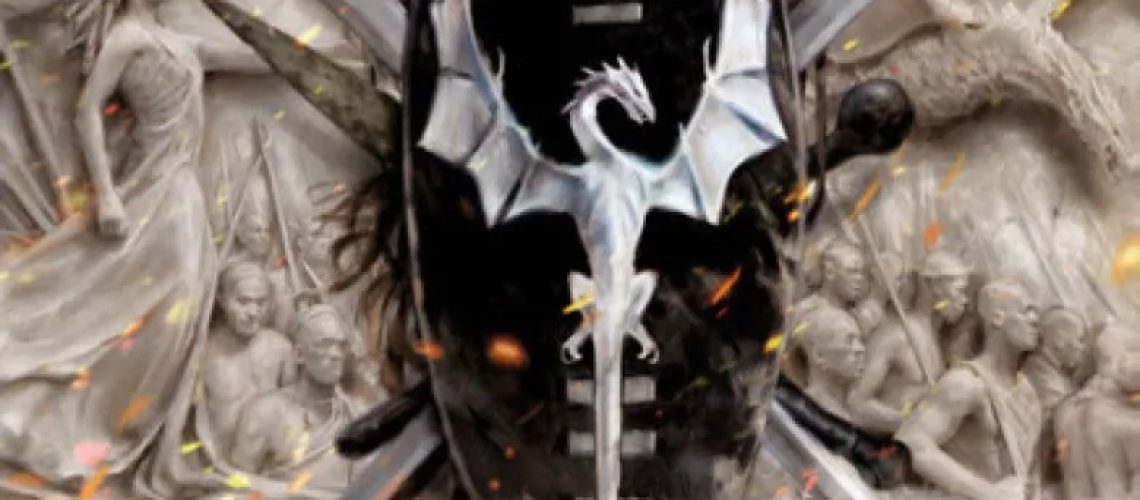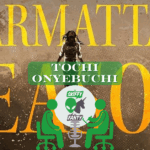Evan Winter self-published The Rage of Dragons in 2017. It soon received notice from an editor at Orbit, and in 2019 the publisher gave a freshly edited version of the novel a release, along with a deal for three further novels in its series entitled The Burning. The second novel of the series, The Fires of Vengeance, has recently been released, and a copy I picked up of that from my local bookshop (for this purchase, the aptly named Burning Books) now sits on my massive TBR stack.
If you’re a regular follower of Skiffy & Fanty, you probably have already at least heard of The Rage of Dragons and its author. We featured Winter in episode #53 of the Signal Boost series (found here), and my fellow reviewer Paul Weimer praised the novel on Goodreads and Twitter. Paul even included it among books recommended to his followers at the start of the SARS-CoV-2 pandemic, right as we all began self-isolating and looking for worlds to escape into within pages. (Also: see Paul’s review on Barnes & Noble here).

The Rage of Dragons explores the Omehi, who have escaped their collapsing empire and the Cull. Fleeing to the shores of a new land to settle, they battle against the Hedeni who already live there. Included in the Omehi forces are women who have inherited rare, distinct magical abilities that can be used in battle, including transforming the greatest of Omehi warriors into near-unstoppable berserker behemoths. However, the strength of the Hedini at defending against their invaders forces the Omehi Queen to call upon the most awesome and dangerous power available: dragons, a hard-to-control risk that will also draw the attention of the Cull from which they fled. The Omehi succeed in driving the Hedini into interior lands and establishing a foothold realm under the rule of the Omehi Queen. Yet, while the Omehi achieve their established settlement, the victory comes at great cost, failing to eradicate the threat of renewed Hedeni attack.
Generations later, Tau Solarin trains with other young male Omehi commoners to serve in the continued war against the Hedeni, whose attacks are escalating. Aspiring to join the elite rank that marks the highest his class may attain, Tau must test for this ability and right along with the other warriors. Failing the test would leave him a common soldier in the front lines or even earn him a demotion to the honorless class below commoner. At first, Tau’s drive for success derives from his desire for Zuri, a childhood girlfriend he wants to marry. However, this changes when his father is unjustly killed by a Nobleman, and Tau finds himself powerless physically – and socially within Omehi class structure – to do anything about it.
Enter the Rage of Tau. Beyond an angered thirst for justice, Tau becomes fueled and consumed by a fire for revenge. He turns every fiber of his being into training to be the best Omehi swordsman ever, and to climb as high as possible in the ranks so that he can be placed for taking the lives of those who wronged him. Tau trains day and night — when awake and even while asleep. The latter involves entering a forbidden demon-populated hellscape linked to the source of a magic into which certain Omehi can tap. Sacrificing himself utterly to his goal for revenge, Tau becomes the Omehi’s most indispensable warrior against the Hedeni, and his unorthodox training methods begin to reveal deeply-hidden secrets regarding the Omehi’s power and societal structure.
For any who haven’t begun Winter’s series yet, let me add my voice to convince you to give it a try. Like many epic fantasy series, its originality and greatest asset lies in the world-building, here inspired by the Xhosa culture of the present-day Eastern Cape region of South Africa. But at its core, the stories and characters will be familiar tropes. In interviews, Winter has spoken about how series like Robert Jordan’s Wheel of Time defined his early fantasy-reading experiences. With the birth of his son, he felt a desire to tell a story from that sort of mold but with characters and a milieu that spoke to their heritage. A story with all the details and action one expects from epic fantasy. But a story that would speak to them.
“Write the perfect story for you. Tell at tale that you would fall in love with. That you would need. Don’t guess at what other readers are looking for. Instead, give yourself what you’re looking for, and you might just find readers who are looking for it too.”
Evan Winter
According to the letter from the editor at Orbit that came with my ARC, The Rage of Dragons was what she was looking for. Her introduction bubbled with excitement at getting to share the book. I began the novel with this in mind, and very rapidly found myself agreeing. The prologue dives immediately into the action while also allowing exposition to set up the key framework of Omehi society and its magical system. Relatively short chapters follow to keep that pace going; they also make it hard for a reader to break one’s attention away. Even when there were things to the novel that I didn’t particularly like, I couldn’t help but keep on reading.
In fact, I considered stopping the novel immediately with its prologue. The intensity of the violence in its battle descriptions put me a bit off. Reviewers – including Winter himself, if I recall – called this a “grittiness” comparable to Joe Abercrombie’s fantasy. Such things once didn’t bother me, but I found the prose to take almost a rapturous delight in the viscera. Paradoxically, like looking at a car wreck scene, these details ended up drawing me into the battle scenes all the more, compelling me forward as I became invested in the characters and, above all, the richly imagined world and its castes.
The pace of The Rage of Dragons along with the righteous indignation and drive for revenge that governs Tau propels readers empathically forward. I wanted to see Tau succeed and to overcome the smug lot of his enemies. Yet it also disturbed me to have those blood-thirsty thoughts of revenge, realizing if this were reality, as opposed to a character in a book, I’d probably be reacting very differently to Tau’s behavior and path. While Tau remains an underdog to cheer for, he also willingly becomes monstrous, ending up a flawed hero.
The only critically problematic aspects of the novel arise from Winter’s drawing elements that I’d consider negative from his past epic fantasy inspiration. I, too, adore The Wheel of Time, but Jordan’s treatment of female characters quite obviously holds a male gaze bias. Winter’s is not as pronounced, but shades of that come through in his writing as well, particularly when the novel turns toward romantic scenes or Tau’s feelings toward Zuri. Secondly, Tau suffers from being an unstoppable hero cliché. Never does a reader doubt that he’s going to get amazingly good at training or stop overcoming physical obstacles. Like in a Drizzt Do’Urden novel, you know he’s going to kick righteous ass no matter what the odds stacked against him. This creates a situation of easy pleasure reward for readers pulling for Tau in his inevitable revengeful victories, but it also cheapens the overall impact of the novel that otherwise focuses on deep issues of war, sacrifice, class, and the enemy other.
Those larger scale societal issues remain a major focus throughout the novel, especially its second half as it builds into broader political intrigue beyond Tau’s personal quest. Along with The Rage of Dragons’ stellar pacing, they represent what kept me reading Winter’s debut novel with rapt interest, and they are what are now calling me to pick up The Fires of Vengeance. I’ll enjoy seeing Tau reach his goals. I’ll be concerned about the instinct to cheer on his bloodthirsty anger. But above all, I’m itching to learn more about the world that Winter has created, the nature of its magic, and what comes of the Omehi and Hedini peoples. They are what makes The Burning successful epic fantasy.







